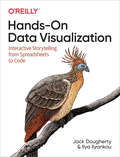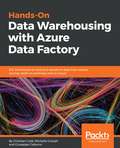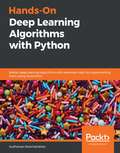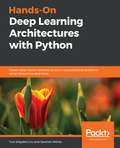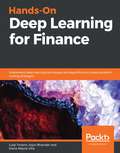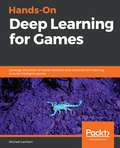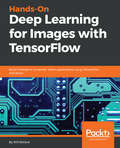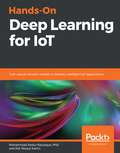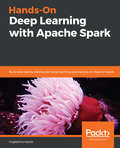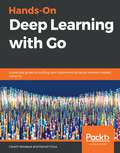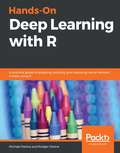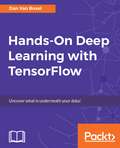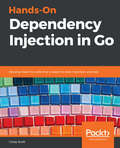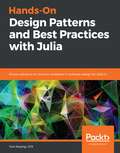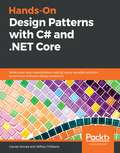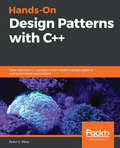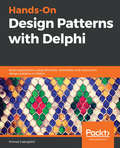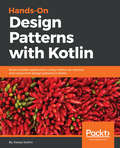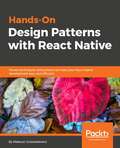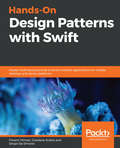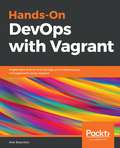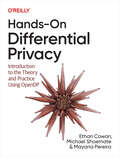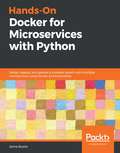- Table View
- List View
Hands-On Data Visualization with Bokeh: Interactive web plotting for Python using Bokeh
by Kevin JollyLearn how to create interactive and visually aesthetic plots using the Bokeh package in Python Key FeaturesA step by step approach to creating interactive plots with BokehGo from nstallation all the way to deploying your very own Bokeh applicationWork with a real time datasets to practice and create your very own plots and applicationsBook DescriptionAdding a layer of interactivity to your plots and converting these plots into applications hold immense value in the field of data science. The standard approach to adding interactivity would be to use paid software such as Tableau, but the Bokeh package in Python offers users a way to create both interactive and visually aesthetic plots for free. This book gets you up to speed with Bokeh - a popular Python library for interactive data visualization.The book starts out by helping you understand how Bokeh works internally and how you can set up and install the package in your local machine. You then use a real world data set which uses stock data from Kaggle to create interactive and visually stunning plots. You will also learn how to leverage Bokeh using some advanced concepts such as plotting with spatial and geo data. Finally you will use all the concepts that you have learned in the previous chapters to create your very own Bokeh application from scratch.By the end of the book you will be able to create your very own Bokeh application. You will have gone through a step by step process that starts with understanding what Bokeh actually is and ends with building your very own Bokeh application filled with interactive and visually aesthetic plots.What you will learnInstalling Bokeh and understanding its key conceptsCreating plots using glyphs, the fundamental building blocks of BokehCreating plots using different data structures like NumPy and PandasUsing layouts and widgets to visually enhance your plots and add a layer of interactivityBuilding and hosting applications on the Bokeh serverCreating advanced plots using spatial dataWho this book is forThis book is well suited for data scientists and data analysts who want to perform interactive data visualization on their web browsers using Bokeh. Some exposure to Python programming will be helpful, but prior experience with Bokeh is not required.
Hands-On Data Visualization: Interactive Storytelling From Spreadsheets To Code
by Jack Dougherty Ilya IlyankouTell your story and show it with data, using free and easy-to-learn tools on the web. This introductory book teaches you how to design interactive charts and customized maps for your website, beginning with simple drag-and-drop tools such as Google Sheets, Datawrapper, and Tableau Public. You'll also gradually learn how to edit open source code templates like Chart.js, Highcharts, and Leaflet on GitHub.Hands-On Data Visualization takes you step-by-step through tutorials, real-world examples, and online resources. This practical guide is ideal for students, nonprofit organizations, small business owners, local governments, journalists, academics, and anyone who wants to take data out of spreadsheets and turn it into lively interactive stories. No coding experience is required.Build interactive charts and maps and embed them in your websiteUnderstand the principles for designing effective charts and mapsLearn key data visualization concepts to help you choose the right toolsConvert and transform tabular and spatial data to tell your data storyEdit and host Chart.js, Highcharts, and Leaflet map code templates on GitHubLearn how to detect bias in charts and maps produced by others
Hands-On Data Warehousing with Azure Data Factory: ETL techniques to load and transform data from various sources, both on-premises and on cloud
by Giuseppe Ciaburro Michelle Kamrat Gutzait Christian CotéLeverage the power of Microsoft Azure Data Factory v2 to build hybrid data solutionsKey FeaturesCombine the power of Azure Data Factory v2 and SQL Server Integration ServicesDesign and enhance performance and scalability of a modern ETL hybrid solutionInteract with the loaded data in data warehouse and data lake using Power BIBook DescriptionETL is one of the essential techniques in data processing. Given data is everywhere, ETL will always be the vital process to handle data from different sources.Hands-On Data Warehousing with Azure Data Factory starts with the basic concepts of data warehousing and ETL process. You will learn how Azure Data Factory and SSIS can be used to understand the key components of an ETL solution. You will go through different services offered by Azure that can be used by ADF and SSIS, such as Azure Data Lake Analytics, Machine Learning and Databrick’s Spark with the help of practical examples. You will explore how to design and implement ETL hybrid solutions using different integration services with a step-by-step approach. Once you get to grips with all this, you will use Power BI to interact with data coming from different sources in order to reveal valuable insights.By the end of this book, you will not only learn how to build your own ETL solutions but also address the key challenges that are faced while building them.What you will learnUnderstand the key components of an ETL solution using Azure Data Factory and Integration ServicesDesign the architecture of a modern ETL hybrid solutionImplement ETL solutions for both on-premises and Azure dataImprove the performance and scalability of your ETL solutionGain thorough knowledge of new capabilities and features added to Azure Data Factory and Integration ServicesWho this book is forThis book is for you if you are a software professional who develops and implements ETL solutions using Microsoft SQL Server or Azure cloud. It will be an added advantage if you are a software engineer, DW/ETL architect, or ETL developer, and know how to create a new ETL implementation or enhance an existing one with ADF or SSIS.
Hands-On Deep Learning Algorithms with Python: Master deep learning algorithms with extensive math by implementing them using TensorFlow
by Sudharsan RavichandiranUnderstand basic to advanced deep learning algorithms, the mathematical principles behind them, and their practical applications. Key Features Get up-to-speed with building your own neural networks from scratch Gain insights into the mathematical principles behind deep learning algorithms Implement popular deep learning algorithms such as CNNs, RNNs, and more using TensorFlow Book Description Deep learning is one of the most popular domains in the AI space, allowing you to develop multi-layered models of varying complexities. This book introduces you to popular deep learning algorithms—from basic to advanced—and shows you how to implement them from scratch using TensorFlow. Throughout the book, you will gain insights into each algorithm, the mathematical principles behind it, and how to implement it in the best possible manner. The book starts by explaining how you can build your own neural networks, followed by introducing you to TensorFlow, the powerful Python-based library for machine learning and deep learning. Moving on, you will get up to speed with gradient descent variants, such as NAG, AMSGrad, AdaDelta, Adam, and Nadam. The book will then provide you with insights into RNNs and LSTM and how to generate song lyrics with RNN. Next, you will master the math for convolutional and capsule networks, widely used for image recognition tasks. Then you learn how machines understand the semantics of words and documents using CBOW, skip-gram, and PV-DM. Afterward, you will explore various GANs, including InfoGAN and LSGAN, and autoencoders, such as contractive autoencoders and VAE. By the end of this book, you will be equipped with all the skills you need to implement deep learning in your own projects. What you will learn Implement basic-to-advanced deep learning algorithms Master the mathematics behind deep learning algorithms Become familiar with gradient descent and its variants, such as AMSGrad, AdaDelta, Adam, and Nadam Implement recurrent networks, such as RNN, LSTM, GRU, and seq2seq models Understand how machines interpret images using CNN and capsule networks Implement different types of generative adversarial network, such as CGAN, CycleGAN, and StackGAN Explore various types of autoencoder, such as Sparse autoencoders, DAE, CAE, and VAE Who this book is for If you are a machine learning engineer, data scientist, AI developer, or simply want to focus on neural networks and deep learning, this book is for you. Those who are completely new to deep learning, but have some experience in machine learning and Python programming, will also find the book very helpful.
Hands-On Deep Learning Architectures with Python: Create deep neural networks to solve computational problems using TensorFlow and Keras
by Yuxi (Hayden) Liu Saransh MehtaConcepts, tools, and techniques to explore deep learning architectures and methodologiesKey FeaturesExplore advanced deep learning architectures using various datasets and frameworksImplement deep architectures for neural network models such as CNN, RNN, GAN, and many moreDiscover design patterns and different challenges for various deep learning architecturesBook DescriptionDeep learning architectures are composed of multilevel nonlinear operations that represent high-level abstractions; this allows you to learn useful feature representations from the data. This book will help you learn and implement deep learning architectures to resolve various deep learning research problems.Hands-On Deep Learning Architectures with Python explains the essential learning algorithms used for deep and shallow architectures. Packed with practical implementations and ideas to help you build efficient artificial intelligence systems (AI), this book will help you learn how neural networks play a major role in building deep architectures. You will understand various deep learning architectures (such as AlexNet, VGG Net, GoogleNet) with easy-to-follow code and diagrams. In addition to this, the book will also guide you in building and training various deep architectures such as the Boltzmann mechanism, autoencoders, convolutional neural networks (CNNs), recurrent neural networks (RNNs), natural language processing (NLP), GAN, and more—all with practical implementations.By the end of this book, you will be able to construct deep models using popular frameworks and datasets with the required design patterns for each architecture. You will be ready to explore the potential of deep architectures in today's world.What you will learnImplement CNNs, RNNs, and other commonly used architectures with PythonExplore architectures such as VGGNet, AlexNet, and GoogLeNetBuild deep learning architectures for AI applications such as face and image recognition, fraud detection, and many moreUnderstand the architectures and applications of Boltzmann machines and autoencoders with concrete examples Master artificial intelligence and neural network concepts and apply them to your architectureUnderstand deep learning architectures for mobile and embedded systemsWho this book is forIf you’re a data scientist, machine learning developer/engineer, or deep learning practitioner, or are curious about AI and want to upgrade your knowledge of various deep learning architectures, this book will appeal to you. You are expected to have some knowledge of statistics and machine learning algorithms to get the best out of this book
Hands-On Deep Learning for Finance: Implement deep learning techniques and algorithms to create powerful trading strategies
by Luigi Troiano Arjun Bhandari Elena Mejuto VillaTake your quantitative strategies to the next level by exploring nine examples that make use of cutting-edge deep learning technologies, including CNNs, LSTMs, GANs, reinforcement learning, and CapsNets Key Features Implement deep learning techniques and algorithms to build financial models Apply modern AI techniques in quantitative market modeling and investment decision making Leverage Python libraries for rapid development and prototyping Book Description Quantitative methods are the vanguard of the investment management industry. This book shows how to enhance trading strategies and investments in financial markets using deep learning algorithms. This book is an excellent reference to understand how deep learning models can be leveraged to capture insights from financial data. You will implement deep learning models using Python libraries such as TensorFlow and Keras. You will learn various deep learning algorithms to build models for understanding financial market dynamics and exploiting them in a systematic manner. This book takes a pragmatic approach to address various aspects of asset management. The information content in non-structured data like news flow is crystalized using BLSTM. Autoencoders for efficient index replication is discussed in detail. You will use CNN to develop a trading signal with simple technical indicators, and improvements offered by more complex techniques such as CapsNets. Volatility is given due emphasis by demonstrating the superiority of forecasts employing LSTM, and Monte Carlo simulations using GAN for value at risk computations. These are then brought together by implementing deep reinforcement learning for automated trading. This book will serve as a continuing reference for implementing deep learning models to build investment strategies. What you will learn Implement quantitative financial models using the various building blocks of a deep neural network Build, train, and optimize deep networks from scratch Use LSTMs to process data sequences such as time series and news feeds Implement convolutional neural networks (CNNs), CapsNets, and other models to create trading strategies Adapt popular neural networks for pattern recognition in finance using transfer learning Automate investment decisions by using reinforcement learning Discover how a risk model can be constructed using D-GAN Who this book is for If you're a finance or investment professional who wants to lead the development of quantitative strategies, this book is for you. With this practical guide, you'll be able to use deep learning methods for building financial models and incorporating them in your investment process. Anyone who wants to enter the fascinating domain of quantitative finance using the power of deep learning algorithms and techniques will also find this book useful. Basic knowledge of machine learning and Python programming is required.
Hands-On Deep Learning for Games: Leverage the power of neural networks and reinforcement learning to build intelligent games
by Micheal LanhamUnderstand the core concepts of deep learning and deep reinforcement learning by applying them to develop games Key Features Apply the power of deep learning to complex reasoning tasks by building a Game AI Exploit the most recent developments in machine learning and AI for building smart games Implement deep learning models and neural networks with Python Book Description The number of applications of deep learning and neural networks has multiplied in the last couple of years. Neural nets has enabled significant breakthroughs in everything from computer vision, voice generation, voice recognition and self-driving cars. Game development is also a key area where these techniques are being applied. This book will give an in depth view of the potential of deep learning and neural networks in game development. We will take a look at the foundations of multi-layer perceptron's to using convolutional and recurrent networks. In applications from GANs that create music or textures to self-driving cars and chatbots. Then we introduce deep reinforcement learning through the multi-armed bandit problem and other OpenAI Gym environments. As we progress through the book we will gain insights about DRL techniques such as Motivated Reinforcement Learning with Curiosity and Curriculum Learning. We also take a closer look at deep reinforcement learning and in particular the Unity ML-Agents toolkit. By the end of the book, we will look at how to apply DRL and the ML-Agents toolkit to enhance, test and automate your games or simulations. Finally, we will cover your possible next steps and possible areas for future learning. What you will learn Learn the foundations of neural networks and deep learning. Use advanced neural network architectures in applications to create music, textures, self driving cars and chatbots. Understand the basics of reinforcement and DRL and how to apply it to solve a variety of problems. Working with Unity ML-Agents toolkit and how to install, setup and run the kit. Understand core concepts of DRL and the differences between discrete and continuous action environments. Use several advanced forms of learning in various scenarios from developing agents to testing games. Who this book is for This books is for game developers who wish to create highly interactive games by leveraging the power of machine and deep learning. No prior knowledge of machine learning, deep learning or neural networks is required this book will teach those concepts from scratch. A good understanding of Python is required.
Hands-On Deep Learning for Images with TensorFlow: Build intelligent computer vision applications using TensorFlow and Keras
by Will BallardExplore TensorFlow's capabilities to perform efficient deep learning on imagesKey FeaturesDiscover image processing for machine visionBuild an effective image classification system using the power of CNNsLeverage TensorFlow’s capabilities to perform efficient deep learningBook DescriptionTensorFlow is Google’s popular offering for machine learning and deep learning, quickly becoming a favorite tool for performing fast, efficient, and accurate deep learning tasks.Hands-On Deep Learning for Images with TensorFlow shows you the practical implementations of real-world projects, teaching you how to leverage TensorFlow’s capabilities to perform efficient image processing using the power of deep learning. With the help of this book, you will get to grips with the different paradigms of performing deep learning such as deep neural nets and convolutional neural networks, followed by understanding how they can be implemented using TensorFlow.By the end of this book, you will have mastered all the concepts of deep learning and their implementation with TensorFlow and Keras.What you will learnBuild machine learning models particularly focused on the MNIST digitsWork with Docker and Keras to build an image classifierUnderstand natural language models to process text and imagesPrepare your dataset for machine learningCreate classical, convolutional, and deep neural networksCreate a RESTful image classification serverWho this book is forHands-On Deep Learning for Images with TensorFlow is for you if you are an application developer, data scientist, or machine learning practitioner looking to integrate machine learning into application software and master deep learning by implementing practical projects in TensorFlow. Knowledge of Python programming and basics of deep learning are required to get the best out of this book.
Hands-On Deep Learning for IoT: Train neural network models to develop intelligent IoT applications
by Md. Rezaul Karim Mohammad Abdur Razzaque, PhDImplement popular deep learning techniques to make your IoT applications smarter Key Features Understand how deep learning facilitates fast and accurate analytics in IoT Build intelligent voice and speech recognition apps in TensorFlow and Chainer Analyze IoT data for making automated decisions and efficient predictions Book Description Artificial Intelligence is growing quickly, which is driven by advancements in neural networks(NN) and deep learning (DL). With an increase in investments in smart cities, smart healthcare, and industrial Internet of Things (IoT), commercialization of IoT will soon be at peak in which massive amounts of data generated by IoT devices need to be processed at scale. Hands-On Deep Learning for IoT will provide deeper insights into IoT data, which will start by introducing how DL fits into the context of making IoT applications smarter. It then covers how to build deep architectures using TensorFlow, Keras, and Chainer for IoT. You'll learn how to train convolutional neural networks(CNN) to develop applications for image-based road faults detection and smart garbage separation, followed by implementing voice-initiated smart light control and home access mechanisms powered by recurrent neural networks(RNN). You'll master IoT applications for indoor localization, predictive maintenance, and locating equipment in a large hospital using autoencoders, DeepFi, and LSTM networks. Furthermore, you'll learn IoT application development for healthcare with IoT security enhanced. By the end of this book, you will have sufficient knowledge need to use deep learning efficiently to power your IoT-based applications for smarter decision making. What you will learn Get acquainted with different neural network architectures and their suitability in IoT Understand how deep learning can improve the predictive power in your IoT solutions Capture and process streaming data for predictive maintenance Select optimal frameworks for image recognition and indoor localization Analyze voice data for speech recognition in IoT applications Develop deep learning-based IoT solutions for healthcare Enhance security in your IoT solutions Visualize analyzed data to uncover insights and perform accurate predictions Who this book is for If you're an IoT developer, data scientist, or deep learning enthusiast who wants to apply deep learning techniques to build smart IoT applications, this book is for you. Familiarity with machine learning, a basic understanding of the IoT concepts, and some experience in Python programming will help you get the most out of this book.
Hands-On Deep Learning with Apache Spark: Build and deploy distributed deep learning applications on Apache Spark
by Guglielmo IozziaSpeed up the design and implementation of deep learning solutions using Apache Spark Key Features Explore the world of distributed deep learning with Apache Spark Train neural networks with deep learning libraries such as BigDL and TensorFlow Develop Spark deep learning applications to intelligently handle large and complex datasets Book Description Deep learning is a subset of machine learning where datasets with several layers of complexity can be processed. Hands-On Deep Learning with Apache Spark addresses the sheer complexity of technical and analytical parts and the speed at which deep learning solutions can be implemented on Apache Spark. The book starts with the fundamentals of Apache Spark and deep learning. You will set up Spark for deep learning, learn principles of distributed modeling, and understand different types of neural nets. You will then implement deep learning models, such as convolutional neural networks (CNNs), recurrent neural networks (RNNs), and long short-term memory (LSTM) on Spark. As you progress through the book, you will gain hands-on experience of what it takes to understand the complex datasets you are dealing with. During the course of this book, you will use popular deep learning frameworks, such as TensorFlow, Deeplearning4j, and Keras to train your distributed models. By the end of this book, you'll have gained experience with the implementation of your models on a variety of use cases. What you will learn Understand the basics of deep learning Set up Apache Spark for deep learning Understand the principles of distribution modeling and different types of neural networks Obtain an understanding of deep learning algorithms Discover textual analysis and deep learning with Spark Use popular deep learning frameworks, such as Deeplearning4j, TensorFlow, and Keras Explore popular deep learning algorithms Who this book is for If you are a Scala developer, data scientist, or data analyst who wants to learn how to use Spark for implementing efficient deep learning models, Hands-On Deep Learning with Apache Spark is for you. Knowledge of the core machine learning concepts and some exposure to Spark will be helpful.
Hands-On Deep Learning with Go: A practical guide to building and implementing neural network models using Go
by Gareth Seneque Darrell ChuaApply modern deep learning techniques to build and train deep neural networks using Gorgonia Key Features Gain a practical understanding of deep learning using Golang Build complex neural network models using Go libraries and Gorgonia Take your deep learning model from design to deployment with this handy guide Book Description Go is an open source programming language designed by Google for handling large-scale projects efficiently. The Go ecosystem comprises some really powerful deep learning tools such as DQN and CUDA. With this book, you'll be able to use these tools to train and deploy scalable deep learning models from scratch. This deep learning book begins by introducing you to a variety of tools and libraries available in Go. It then takes you through building neural networks, including activation functions and the learning algorithms that make neural networks tick. In addition to this, you'll learn how to build advanced architectures such as autoencoders, restricted Boltzmann machines (RBMs), convolutional neural networks (CNNs), recurrent neural networks (RNNs), and more. You'll also understand how you can scale model deployments on the AWS cloud infrastructure for training and inference. By the end of this book, you'll have mastered the art of building, training, and deploying deep learning models in Go to solve real-world problems. What you will learn Explore the Go ecosystem of libraries and communities for deep learning Get to grips with Neural Networks, their history, and how they work Design and implement Deep Neural Networks in Go Get a strong foundation of concepts such as Backpropagation and Momentum Build Variational Autoencoders and Restricted Boltzmann Machines using Go Build models with CUDA and benchmark CPU and GPU models Who this book is for This book is for data scientists, machine learning engineers, and AI developers who want to build state-of-the-art deep learning models using Go. Familiarity with basic machine learning concepts and Go programming is required to get the best out of this book.
Hands-On Deep Learning with R: A practical guide to designing, building, and improving neural network models using R
by Michael Pawlus Rodger DevineExplore and implement deep learning to solve various real-world problems using modern R libraries such as TensorFlow, MXNet, H2O, and Deepnet Key Features Understand deep learning algorithms and architectures using R and determine which algorithm is best suited for a specific problem Improve models using parameter tuning, feature engineering, and ensembling Apply advanced neural network models such as deep autoencoders and generative adversarial networks (GANs) across different domains Book Description Deep learning enables efficient and accurate learning from a massive amount of data. This book will help you overcome a number of challenges using various deep learning algorithms and architectures with R programming. This book starts with a brief overview of machine learning and deep learning and how to build your first neural network. You'll understand the architecture of various deep learning algorithms and their applicable fields, learn how to build deep learning models, optimize hyperparameters, and evaluate model performance. Various deep learning applications in image processing, natural language processing (NLP), recommendation systems, and predictive analytics will also be covered. Later chapters will show you how to tackle recognition problems such as image recognition and signal detection, programmatically summarize documents, conduct topic modeling, and forecast stock market prices. Toward the end of the book, you will learn the common applications of GANs and how to build a face generation model using them. Finally, you'll get to grips with using reinforcement learning and deep reinforcement learning to solve various real-world problems. By the end of this deep learning book, you will be able to build and deploy your own deep learning applications using appropriate frameworks and algorithms. What you will learn Design a feedforward neural network to see how the activation function computes an output Create an image recognition model using convolutional neural networks (CNNs) Prepare data, decide hidden layers and neurons and train your model with the backpropagation algorithm Apply text cleaning techniques to remove uninformative text using NLP Build, train, and evaluate a GAN model for face generation Understand the concept and implementation of reinforcement learning in R Who this book is for This book is for data scientists, machine learning engineers, and deep learning developers who are familiar with machine learning and are looking to enhance their knowledge of deep learning using practical examples. Anyone interested in increasing the efficiency of their machine learning applications and exploring various options in R will also find this book useful. Basic knowledge of machine learning techniques and working knowledge of the R programming language is expected.
Hands-On Deep Learning with TensorFlow
by Dan Van BoxelThis book is your guide to exploring the possibilities in the field of deep learning, making use of Google's TensorFlow. You will learn about convolutional neural networks, and logistic regression while training models for deep learning to gain key insights into your data. About This Book • Explore various possibilities with deep learning and gain amazing insights from data using Google's brainchild-- TensorFlow • Want to learn what more can be done with deep learning? Explore various neural networks with the help of this comprehensive guide • Rich in concepts, advanced guide on deep learning that will give you background to innovate in your environment Who This Book Is For If you are a data scientist who performs machine learning on a regular basis, are familiar with deep neural networks, and now want to gain expertise in working with convoluted neural networks, then this book is for you. Some familiarity with C++ or Python is assumed. What You Will Learn • Set up your computing environment and install TensorFlow • Build simple TensorFlow graphs for everyday computations • Apply logistic regression for classification with TensorFlow • Design and train a multilayer neural network with TensorFlow • Intuitively understand convolutional neural networks for image recognition • Bootstrap a neural network from simple to more accurate models • See how to use TensorFlow with other types of networks • Program networks with SciKit-Flow, a high-level interface to TensorFlow In Detail Dan Van Boxel's Deep Learning with TensorFlow is based on Dan's best-selling TensorFlow video course. With deep learning going mainstream, making sense of data and getting accurate results using deep networks is possible. Dan Van Boxel will be your guide to exploring the possibilities with deep learning; he will enable you to understand data like never before. With the efficiency and simplicity of TensorFlow, you will be able to process your data and gain insights that will change how you look at data. With Dan's guidance, you will dig deeper into the hidden layers of abstraction using raw data. Dan then shows you various complex algorithms for deep learning and various examples that use these deep neural networks. You will also learn how to train your machine to craft new features to make sense of deeper layers of data. In this book, Dan shares his knowledge across topics such as logistic regression, convolutional neural networks, recurrent neural networks, training deep networks, and high level interfaces. With the help of novel practical examples, you will become an ace at advanced multilayer networks, image recognition, and beyond. Style and Approach This book is your go-to guide to becoming a deep learning expert in your organization. Dan helps you evaluate common and not-so-common deep neural networks with the help of insightful examples that you can relate to, and show how they can be exploited in the real world with complex raw data.
Hands-On Dependency Injection in Go
by Corey ScottProgrammers with a few years experience in any language and a basic understanding of Go who wish to produce clean, loosely coupled code.
Hands-On Design Patterns and Best Practices with Julia: Proven solutions to common problems in software design for Julia 1.x
by Tom Kwong Stefan KarpinskiDesign and develop high-performance, reusable, and maintainable applications using traditional and modern Julia patterns with this comprehensive guide Key Features Explore useful design patterns along with object-oriented programming in Julia 1.0 Implement macros and metaprogramming techniques to make your code faster, concise, and efficient Develop the skills necessary to implement design patterns for creating robust and maintainable applications Book Description Design patterns are fundamental techniques for developing reusable and maintainable code. They provide a set of proven solutions that allow developers to solve problems in software development quickly. This book will demonstrate how to leverage design patterns with real-world applications. Starting with an overview of design patterns and best practices in application design, you'll learn about some of the most fundamental Julia features such as modules, data types, functions/interfaces, and metaprogramming. You'll then get to grips with the modern Julia design patterns for building large-scale applications with a focus on performance, reusability, robustness, and maintainability. The book also covers anti-patterns and how to avoid common mistakes and pitfalls in development. You'll see how traditional object-oriented patterns can be implemented differently and more effectively in Julia. Finally, you'll explore various use cases and examples, such as how expert Julia developers use design patterns in their open source packages. By the end of this Julia programming book, you'll have learned methods to improve software design, extensibility, and reusability, and be able to use design patterns efficiently to overcome common challenges in software development. What you will learn Master the Julia language features that are key to developing large-scale software applications Discover design patterns to improve overall application architecture and design Develop reusable programs that are modular, extendable, performant, and easy to maintain Weigh up the pros and cons of using different design patterns for use cases Explore methods for transitioning from object-oriented programming to using equivalent or more advanced Julia techniques Who this book is for This book is for beginner to intermediate-level Julia programmers who want to enhance their skills in designing and developing large-scale applications.
Hands-On Design Patterns with C# and .NET Core: Write clean and maintainable code by using reusable solutions to common software design problems
by Gaurav Aroraa Jeffrey ChilbertoApply design patterns to solve problems in software architecture and programming using C# 7.x and .NET Core 2 Key Features Enhance your programming skills by implementing efficient design patterns for C# and .NET Explore design patterns for functional and reactive programming to build robust and scalable applications Discover how to work effectively with microservice and serverless architectures Book Description Design patterns are essentially reusable solutions to common programming problems. When used correctly, they meet crucial software requirements with ease and reduce costs. This book will uncover effective ways to use design patterns and demonstrate their implementation with executable code specific to both C# and .NET Core. Hands-On Design Patterns with C# and .NET Core begins with an overview of object-oriented programming (OOP) and SOLID principles. It provides an in-depth explanation of the Gang of Four (GoF) design patterns such as creational, structural, and behavioral. The book then takes you through functional, reactive, and concurrent patterns, helping you write better code with streams, threads, and coroutines. Toward the end of the book, you'll learn about the latest trends in architecture, exploring design patterns for microservices, serverless, and cloud native applications. You'll even understand the considerations that need to be taken into account when choosing between different architectures such as microservices and MVC. By the end of the book, you will be able to write efficient and clear code and be comfortable working on scalable and maintainable projects of any size. What you will learn Make your code more flexible by applying SOLID principles Follow the Test-driven development (TDD) approach in your .NET Core projects Get to grips with efficient database migration, data persistence, and testing techniques Convert a console application to a web application using the right MVP Write asynchronous, multithreaded, and parallel code Implement MVVM and work with RxJS and AngularJS to deal with changes in databases Explore the features of microservices, serverless programming, and cloud computing Who this book is for If you have a basic understanding of C# and the .NET Core framework, this book will help you write code that is easy to reuse and maintain with the help of proven design patterns that you can implement in your code.
Hands-On Design Patterns with C++: Solve common C++ problems with modern design patterns and build robust applications
by Fedor G PikusC++ developers who are comfortable in programming in C++ and now want to learn how to implement design patterns to create robust, reusable and easily maintainable apps.
Hands-On Design Patterns with Delphi: Build applications using idiomatic, extensible, and concurrent design patterns in Delphi
by Primoz GabrijelcicThis book is aimed at beginner to intermediate level Delphi developers who want to build scalable and robust applications. Basic knowledge of Delphi is required and all the advanced Delphi concepts are explained in the book.
Hands-On Design Patterns with Java: Learn design patterns that enable the building of large-scale software architectures
by Dr. Edward LavieriUnderstand Gang of Four, architectural, functional, and reactive design patterns and how to implement them on modern Java platforms, such as Java 12 and beyondKey FeaturesLearn OOP, functional, and reactive patterns for creating readable and maintainable codeExplore architectural patterns and practices for building scalable and reliable applicationsTackle all kinds of performance-related issues and streamline development using design patternsBook DescriptionJava design patterns are reusable and proven solutions to software design problems. This book covers over 60 battle-tested design patterns used by developers to create functional, reusable, and flexible software. Hands-On Design Patterns with Java starts with an introduction to the Unified Modeling Language (UML), and delves into class and object diagrams with the help of detailed examples. You'll study concepts and approaches to object-oriented programming (OOP) and OOP design patterns to build robust applications. As you advance, you'll explore the categories of GOF design patterns, such as behavioral, creational, and structural, that help you improve code readability and enable large-scale reuse of software. You’ll also discover how to work effectively with microservices and serverless architectures by using cloud design patterns, each of which is thoroughly explained and accompanied by real-world programming solutions. By the end of the book, you’ll be able to speed up your software development process using the right design patterns, and you’ll be comfortable working on scalable and maintainable projects of any size.What you will learnUnderstand the significance of design patterns for software engineeringVisualize software design with UML diagramsStrengthen your understanding of OOP to create reusable software systemsDiscover GOF design patterns to develop scalable applicationsExamine programming challenges and the design patterns that solve themExplore architectural patterns for microservices and cloud developmentWho this book is forIf you are a developer who wants to learn how to write clear, concise, and effective code for building production-ready applications, this book is for you. Familiarity with the fundamentals of Java is assumed.
Hands-On Design Patterns with Kotlin: Build scalable applications using traditional, reactive, and concurrent design patterns in Kotlin
by Alexey SoshinMake the most of Kotlin by leveraging design patterns and best practices to build scalable and high performing appsKey Features Understand traditional GOF design patterns to apply generic solutions Shift from OOP to FP; covering reactive and concurrent patterns in a step-by-step manner Choose the best microservices architecture and MVC for your development environmentBook DescriptionDesign patterns enable you as a developer to speed up the development process by providing you with proven development paradigms. Reusing design patterns helps prevent complex issues that can cause major problems, improves your code base, promotes code reuse, and makes an architecture more robust.The mission of this book is to ease the adoption of design patterns in Kotlin and provide good practices for programmers. The book begins by showing you the practical aspects of smarter coding in Kotlin, explaining the basic Kotlin syntax and the impact of design patterns. From there, the book provides an in-depth explanation of the classical design patterns of creational, structural, and behavioral families, before heading into functional programming. It then takes you through reactive and concurrent patterns, teaching you about using streams, threads, and coroutines to write better code along the way By the end of the book, you will be able to efficiently address common problems faced while developing applications and be comfortable working on scalable and maintainable projects of any size.What you will learn Get to grips with Kotlin principles, including its strengths and weaknesses Understand classical design patterns in Kotlin Explore functional programming using built-in features of Kotlin Solve real-world problems using reactive and concurrent design patterns Use threads and coroutines to simplify concurrent code flow Understand antipatterns to write clean Kotlin code, avoiding common pitfalls Learn about the design considerations necessary while choosing between architecturesWho this book is forThis book is for developers who would like to master design patterns with Kotlin to build efficient and scalable applications. Basic Java or Kotlin programming knowledge is assumed
Hands-On Design Patterns with React Native: Proven techniques and patterns for efficient native mobile development with JavaScript
by Mateusz GrzesiukiewiczLearn how to write cross platform React Native code by using effective design patterns in the JavaScript world. Get to know industry standard patterns as well as situational patterns. Decouple your application with these set of “Idea patterns”.Key FeaturesMobile development in React Native should be done in a reusable way. Learn how to build scalable applications using JavaScript patterns that are battle tested.Try effective techniques on your own using over 80 standalone examples.Book DescriptionReact Native helps developers reuse code across different mobile platforms like iOS and Android.This book will show you effective design patterns in the React Native world and will make you ready for professional development in big teams.The book will focus only on the patterns that are relevant to JavaScript, ECMAScript, React and React Native. However, you can successfully transfer a lot of the skills and techniques to other languages. I call them “Idea patterns”.This book will start with the most standard development patterns in React like component building patterns, styling patterns in React Native and then extend these patterns to your mobile application using real world practical examples. Each chapter comes with full, separate source code of applications that you can build and run on your phone.The book is also diving into architectural patterns. Especially how to adapt MVC to React environment. You will learn Flux architecture and how Redux is implementing it. Each approach will be presented with its pros and cons. You will learn how to work with external data sources using libraries like Redux thunk and Redux Saga.The end goal is the ability to recognize the best solution for a given problem for your next mobile application.What you will learnExplore the design Patterns in React NativeLearn the best practices for React Native developmentExplore common React patterns that are highly used within React Native developmentLearn to decouple components and use dependency injection in your applicationsExplore the best ways of fetching data from the backend systemsLearn the styling patterns and how to implement custom mobile designsExplore the best ways to organize your application code in big codebasesWho this book is forThe ideal target audience for this book are people eager to learn React Native design patterns who already know the basics of JavaScript. We can assume that the target audience already knows how to write Hello World in JavaScript and know what are the functions, recursive functions, JavaScript types and loops.
Hands-On Design Patterns with Swift: Master Swift Best Practices To Build Modular Applications For Mobile, Desktop, And Server Platforms
by Florent VilmartThis book is for intermediate developers who want to apply design patterns with Swift to structure and scale their applications. You are expected to have basic knowledge of iOS and Swift.
Hands-On DevOps with Vagrant: Implement end-to-end DevOps and infrastructure management using Vagrant
by Alex BrauntonUse Vagrant to easily build complete development environmentsKey FeaturesImplement DevOps with Vagrant effectivelyIntegrate Vagrant with different tools such as Puppet, Chef, and DockerManage infrastructure with a practical approachBook DescriptionHands-On DevOps with Vagrant teaches you how to use Vagrant as a powerful DevOps tool and gives an overview of how it fits into the DevOps landscape. You will learn how to install VirtualBox and Vagrant in Windows, macOS, and Linux. You will then move on to understanding Vagrant commands, discovering its boxes and Vagrant Cloud.After getting to grips with the basics, the next set of chapters helps you to understand how to configure Vagrant, along with networking. You will explore multimachine, followed by studying how to create multiple environments and the communication between them. In addition to this, you will cover concepts such as Vagrant plugins and file syncing.The last set of chapters provides insights into provisioning shell scripts, also guiding you in how to use Vagrant with configuration management tools such as Chef, Ansible, Docker, Puppet, and Salt.By the end of this book, you will have grasped Vagrant’s features and how to use them for your benefit with the help of tips and tricks.What you will learnExplore what development features Vagrant offersInstall Vagrant and VirtualBox on Windows, macOS and LinuxHarness the power of Vagrant to create powerful development environmentsUtilize DevOps tools such as Docker, Chef, and PuppetUnderstand everything about Vagrant, including networking, plugins, and provisioningUse the Vagrant Cloud to install and manage Vagrant boxesWho this book is forHands-On DevOps with Vagrant is for you if you are a system administrator, DevOps engineer, DevOps architect, or any stakeholder working with DevOps and wanting to explore Vagrant. Experience in system administration is needed to enjoy this book.
Hands-On Differential Privacy
by Ethan Cowan Michael Shoemate Mayana PereiraMany organizations today analyze and share large, sensitive datasets about individuals. Whether these datasets cover healthcare details, financial records, or exam scores, it's become more difficult for organizations to protect an individual's information through deidentification, anonymization, and other traditional statistical disclosure limitation techniques. This practical book explains how differential privacy (DP) can help.Authors Ethan Cowan, Michael Shoemate, and Mayana Pereira explain how these techniques enable data scientists, researchers, and programmers to run statistical analyses that hide the contribution of any single individual. You'll dive into basic DP concepts and understand how to use open source tools to create differentially private statistics, explore how to assess the utility/privacy trade-offs, and learn how to integrate differential privacy into workflows.With this book, you'll learn:How DP guarantees privacy when other data anonymization methods don'tWhat preserving individual privacy in a dataset entailsHow to apply DP in several real-world scenarios and datasetsPotential privacy attack methods, including what it means to perform a reidentification attackHow to use the OpenDP library in privacy-preserving data releasesHow to interpret guarantees provided by specific DP data releases
Hands-On Docker for Microservices with Python: Design, deploy, and operate a complex system with multiple microservices using Docker and Kubernetes
by Jaime BueltaA step-by-step guide to building microservices using Python and Docker, along with managing and orchestrating them with Kubernetes Key Features Learn to use Docker containers to create, operate, and deploy your microservices Create workflows to manage independent deployments on coordinating services using CI and GitOps through GitHub, Travis CI, and Flux Develop a REST microservice in Python using the Flask framework and Postgres database Book Description Microservices architecture helps create complex systems with multiple, interconnected services that can be maintained by independent teams working in parallel. This book guides you on how to develop these complex systems with the help of containers. You'll start by learning to design an efficient strategy for migrating a legacy monolithic system to microservices. You'll build a RESTful microservice with Python and learn how to encapsulate the code for the services into a container using Docker. While developing the services, you'll understand how to use tools such as GitHub and Travis CI to ensure continuous delivery (CD) and continuous integration (CI). As the systems become complex and grow in size, you'll be introduced to Kubernetes and explore how to orchestrate a system of containers while managing multiple services. Next, you'll configure Kubernetes clusters for production-ready environments and secure them for reliable deployments. In the concluding chapters, you'll learn how to detect and debug critical problems with the help of logs and metrics. Finally, you'll discover a variety of strategies for working with multiple teams dealing with different microservices for effective collaboration. By the end of this book, you'll be able to build production-grade microservices as well as orchestrate a complex system of services using containers. What you will learn Discover how to design, test, and operate scalable microservices Coordinate and deploy different services using Kubernetes Use Docker to construct scalable and manageable applications with microservices Understand how to monitor a complete system to ensure early detection of problems Become well versed with migrating from an existing monolithic system to a microservice one Use load balancing to ensure seamless operation between the old monolith and the new service Who this book is for This book is for developers, engineers, or software architects who are trying to move away from traditional approaches for building complex multi-service systems by adopting microservices and containers. Although familiarity with Python programming is assumed, no prior knowledge of Docker is required.

